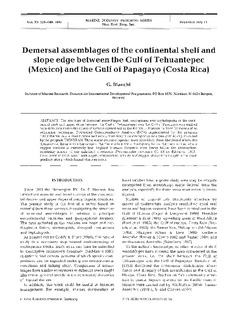| dc.description.abstract | The structure of demersal assemblages (fish, crustaceans and cephalopods) of the continental shelf and upper slope between the Gulf of Tehuantepec and the Gulf of Papagayo was studied from data obtained in the course of surveys carried out by the RV 'Dr. F. Nansen' in 1987, by means of an ordination technique, Detrended Correspondence Analysis (DCA) implemented by the program DECORANA, and a classification technique, Two-Way Indicator Species Analysis (TWIA) implemented by the program TWINSPAN. Three major groups of species were identified: those distributed above the thermocline, those within the range of the thermocline and a third group below the thermocline, where oxygen content is extremely low. Highest biomass densities were found below the thermocline, consisting mainly of the galatheid crustacean Pleuroncodes monodon (H. Milne Edwards, 1837). Correlation of DCA Axis 1 with depth, temperature, salinity and oxygen showed that depth is the main gradient along which faunal changes occur. | en |
